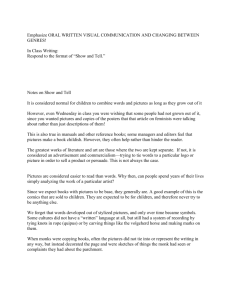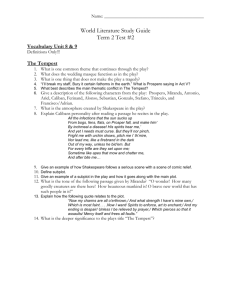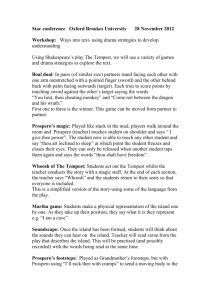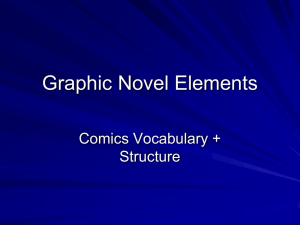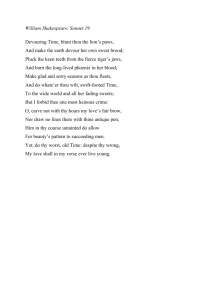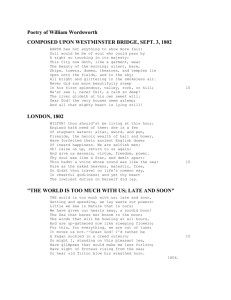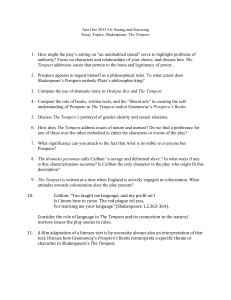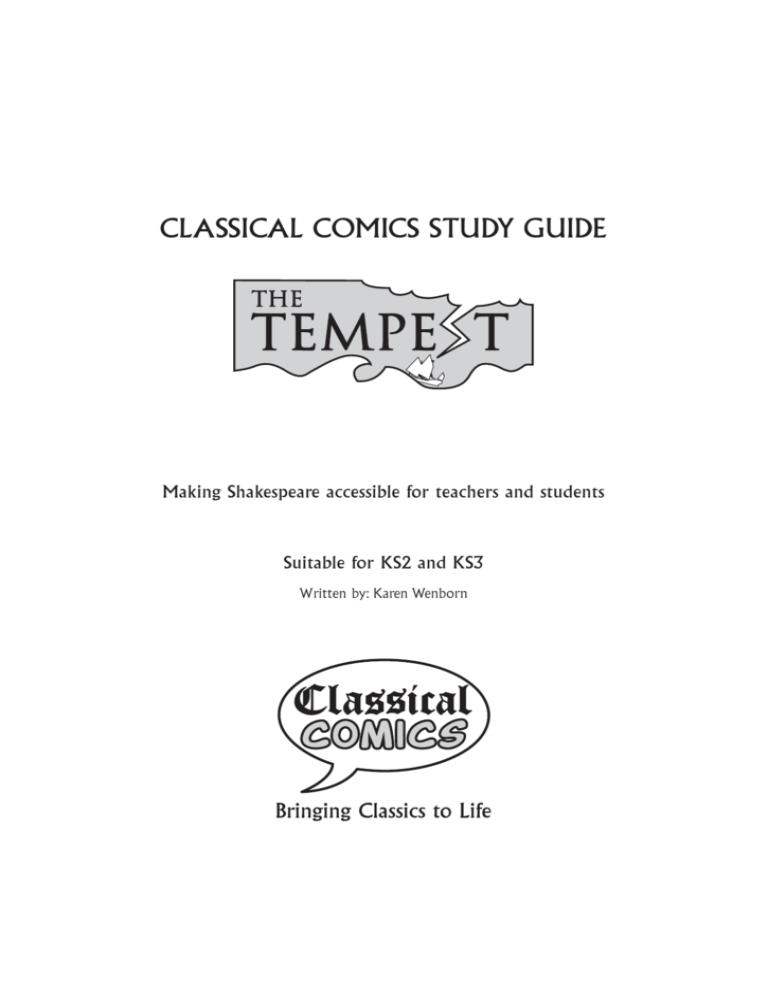
CLASSICAL COMICS STUDY GUIDE
Making Shakespeare accessible for teachers and students
Suitable for KS2 and KS3
Written by: Karen Wenborn
CLASSICAL COMICS STUDY GUIDE
The Tempest
First UK Edition
Copyright ©2007 Classical Comics Ltd.
All rights reserved.
Copyright notice: This downloadable resource is protected by
international copyright law. Teachers and students are free to
reproduce these pages by any method without infringing
copyright restrictions, provided that the number of copies
reproduced does not exceed the amount reasonably required
for their own use.
Under no circumstances can these resources be reused in whole
or in part, for any commercial purposes, or for any purposes that
are competitive to, or could be deemed to be in competition with,
the business of Classical Comics Ltd.
Written by: Karen Wenborn
Design/Layout by: Jo Wheeler
Character designs & original artwork by: Jon Haward
Inked by: Gary Erskine
Lettering: Clive Bryant
Rights: The rights of Jon Haward, Gary Erskine and Clive Bryant
to be identified as artists of this work have been asserted in
accordance with the Copyright, Designs and Patents Act 1988
sections 77 and 78.
Acknowledgments: Every effort has been made to trace
copyright holders of material reproduced in this book. Any rights
not acknowledged here will be acknowledged in subsequent
editions if notice is given to Classical Comics Ltd.
All enquiries should be addressed to:
Classical Comics Ltd.
PO Box 7280
Litchborough
Towcester
NN12 9AR, UK
Tel: 0845 812 3000
education@classicalcomics.com
www.classicalcomics.com
Whilst all care has been taken to ensure the accuracy of the information
provided, Classical Comics Ltd disclaims all warranties; expressed or implied, for
any errors or omissions. Classical Comics Ltd are not responsible or liable for any
alleged damage arising from reliance upon the information provided, which is
provided “as-is” without guarantee or warranty.
Classical Comics Study Guide: The Tempest
CONTENTS
LANGUAGE
Metaphors & Similes ....................................................................................................................4
Missing Words ................................................................................................................................5
How Insulting! ................................................................................................................................6
Connect the Quotes ......................................................................................................................8
Word Search ................................................................................................................................10
PERFORMANCE
Performing the Play ....................................................................................................................11
UNDERSTANDING THE PLAY
Character & Motivation ..............................................................................................................13
Ideas, Themes & Issues ............................................................................................................14
ANSWERS
Word Search Solution ................................................................................................................15
Classical Comics Study Guide: The Tempest
Language
METAPHORS AND SIMILES
WORKSHEET 1
Re-read the text looking for examples of metaphor
and simile.
If possible, underline or highlight them when you
find them. Put ‘M’ or ‘S’ in the margin next to each
one. If you have time, look for other examples of
metaphor and simile in the play.
TASK:
Discuss this as a group. Have you identified them
correctly?
Look again at the following images from the
speeches and from other parts of the play.
Explain what is being said in these
speeches.
“Nor go neither – but you’ll lie like dogs, and yet say
nothing neither.”
“What a pied ninny’s this!”
“We are such stuff
As dreams are made on; and our little life
Is rounded with a sleep.”
“This was well done, my bird!
Thy shape invisible retain thou still.
The trumpery in my house, go bring it hither,
For stale to catch these thieves.”
“A devil, a born devil, on whose nature
Nurture can never stick – on whom my pains,
Humanely taken, all, all lost, quite lost!
And as with age his body uglier grows,
So his mind cankers. I will plague them all,
Even to roaring.”
“Monster, come, put some lime upon your fingers, and
away with the rest.”
“Go charge my goblins that they grind their joints
With dry convulsions; shorten up their sinews
With aged cramps – and more pinch-spotted make them
Than pard or cat-o’-mountain!”
4
Classical Comics Study Guide: The Tempest
Language
MISSING WORDS
WORKSHEET 2
MISSING WORDS
To complete the sentences below, underline the correct word in the box, and then write it in the gap.
Be careful – there are some traps in the box!
1.
2.
3.
4.
Let them be
soundly. At this hour
Lies at my mercy all mine enemies.
Shortly shall all my -------- end, and thou
Shalt have the air at freedom. For a little
Follow, and do me service.
Monster, lay-to your fingers! Help to bear this away
where my
of wine is, or I’ll turn you out of my
kingdom. Go to, carry this!
Let it alone, thou fool! It is but
6.
Thou
7.
Monster, I do smell all
is in great indignation.
smoking
part
passion
man
.
knife
9.
This is strange. Your father’s in some
That works him strongly.
I did not give the lie! Out o’your
, and
too?
A pox o’your bottle! This can sack and drinking do.
5
word
hearing
wert
spurn
punishments
spear
turn
dignity
kill
brave
mock
barnacles
blood
wits
trash
hang
– at which my nose
good
horse-piss
words
but a lost monster.
bad
deformity
undo
honour
tie
beggar
sword
hogshead
kind
forgiveness
virtuous
8.
apes
kindness
, Trinculo. By this hand, I’ll have that
5.
remorse
gown
bind
I will have none on’t! We shall lose our time,
, or to
And all be turned to
With foreheads villainous low.
Put off that
gown!
hunted
state
good
tease
confuse
staff
labours
mood
head
state
manure
senses
stink
Classical Comics Study Guide: The Tempest
Language
SHAKESPEARE’S INSULTS!
WORKSHEET 3
Shakespeare often made up his own words, especially when he wanted to create strong images. Many of
these were used by characters to insult each other. Can you work out which words are still used today?
Match one word from Column 1 with one word from Column 2 and one from Column 3. Cut them out and
shuffle them around. Try different combinations to see who can produce the most offensive insult!
Put the word ‘thou’ (you) at the beginning and you have a sentence.
Words made from putting two words together are called compound words. Can you work out what some
of them might mean?
Column 1:
Adjective
Column 2:
Compound Adjective
Column 3:
Nouns and Compound Nouns
artless
bawdy
beslubbering
bootless
burly-boned
caluminous
churlish
cockered
clouted
craven
cullionly
currish
dankish
dissembling
droning
errant
fawning
fishified
fobbing
frothy
fusty
gleeking
goatish
gorbellied
impertinent
infectious
jarring
loggerheaded
base-court
bat-fowling
beef-witted
beetle-headed
boil-brained
brazen-faced
bunch-back’d
clapper-clawed
clay-brained
common-kissing
crook-pated
dismal-dreaming
dizzy-eyed
doghearted
dread-bolted
earth-vexing
elf-skinned
fat-kidneyed
fen-sucked
flap-mouthed
fly-bitten
folly-fallen
fool-born
full-gorged
guts-griping
half-faced
hasty-witted
hedge-born
apple-john
baggage
barnacle
basket-cockle
bladder
blind-worm
boar-pig
braggart
bugbear
canker-blossom
clotpole
coxcomb
codpiece
cur
death-token
devil-monk
dewberry
flap-dragon
flax-wench
flirt-gill
foot-licker
fustilarian
giglet
gudgeon
haggard
harpy
hedge-pig
horn-beast
lumpish
mammering
mangled
misbegotten
mewling
odiferous
hell-hated
idle-headed
ill-breeding
ill-nurtured
knotty-pated
leaden-footed
hugger-mugger
jolt-head
lewdster
lout
malcontent
maggot-pie
6
Classical Comics Study Guide: The Tempest
Language
Column 1:
Adjective
Column 2:
Compound Adjective
Column 3:
Nouns and Compound Nouns
paunchy
poisonous
pribbling
puking
puny
qualling
rampallian
rank
reeky
roguish
ruttish
saucy
spleeny
spongy
surly
tottering
unmuzzled
unwash’d
venomed
villainous
warped
wart-necked
wayward
weedy
whoreson
lily-livered
malmsey-nosed
milk-livered
motley-minded
muddy-mettled
onion-eyed
pigeon-liver’d
plume-plucked
pottle-deep
pox-marked
reeling-ripe
rough-hewn
rude-growing
rump-fed
scale-sided
scurvy-valiant
shard-borne
sheep-biting
spur-galled
swag-bellied
tardy-gaited
tickle-brained
toad-spotted
unchin-snouted
weather-bitten
malt-worm
mammet
measle
minnow
miscreant
mouldwarp
mumble-news
nut-hook
pigeon-egg
pignut
popinjay
puttock
pumpion
rascal
ratsbane
scullion
scut
skainsmate
strumpet
toad
varlot
vassal
whey-face
wagtail
yoke-devil
GAME:
Divide the class into two. Line up the two halves facing each other, making Line 1 and Line 2. This may be
best done outside! Take turns to shout out words from the list as follows:
1.
The first person in Line 1 calls out a word of his or her choice from Column 1.
2.
The first person in Line 2 has to respond with a word starting with the same letter from Column 2.
3.
The second person in Line 1 then completes the insult with any word from Column 3.
4.
The process starts again with the second person in Line 2,
and so on.
Optional extra rule:
Everyone must listen and try to avoid repeating
words that have already been called out.
Anyone who repeats a word is ‘out’ and has to
leave the line.
The game continues until only a few people are
left or the words have all been used up.
7
Classical Comics Study Guide: The Tempest
Language
CONNECT THE QUOTES
WORKSHEET 4
Connect the Quotes - who said what?
A game played in pairs.
Cut out and use the quotations suggested here, and why not select and add more of your own in the
blank squares.
Drink, servantmonster, when I
bid thee!
Thy eyes are
almost set in thy
head.
Moon-calf, speak
once in thy life,
if thou beest a
good moon-calf.
Trinculo, run into
no further
danger! Interrupt
the monster one
word further, and,
by this hand, I’ll
turn my mercy
out o’doors, and
make a stockfish
of thee.
Is it so brave a
lass?
Lead, monster.
We’ll follow. I
would I could
see this
taborer: he lays
it on.
I will fetch off my
bottle, though I
be o’er ears for
my labour.
Silver! There it
goes, Silver!
I go, I go.
Thou liest.
Thy thoughts I
cleave to. What’s
thy pleasure?
This will I tell my
master.
Monster, come,
put some lime
upon your
fingers, and
away with the
rest.
Thou wert but a
lost monster.
Do, do! We steal
by line and level,
an it like your
grace.
O King
Stephano! O
peer! O worthy
Stephano!
Look what
wardrobe here is
for thee!
Pray you, tread
softly, that the
blind mole may
not hear a foot
fall. We now are
near his cell.
Say again, where
didst thou leave
these varlets?
This is strange.
Your father’s in
some passion
That works him
strongly.
Give me thy
hand. I am sorry
I beat thee: but,
while
thou liv’st, keep a
good tongue in
thy head.
Monster, I will kill
this man. His
daughter and I
will be king and
queen – save our
graces! – and
Trinculo and
thyself shall be
viceroys. Dost
thou like the plot,
I did not give the
lie! Out o’your
wits, and hearing
too? A pox o’your
bottle! This can
sack and drinking
do. A murrain on
your monster, and
the devil take your
fingers!
Each student draws one quote out of the bag at a time, and links it to the correct character. The first to
get a line of four ‘wins’. You can use the grid on the next page.
8
Classical Comics Study Guide: The Tempest
Language
CONNECT THE QUOTES
CALIBAN
STEPHANO
TRINCULO
ARIAL
9
PROSPERO
FERDINAND
MIRANDA
Classical Comics Study Guide: The Tempest
Language
WORD SEARCH
WORKSHEET 5
Find each of the following words. They could run in any direction, including backwards!
SORCERER
BEAST
INSUBSTANTIAL
REVENGE
TYRANT
MUTINEER
JOCUND
SUPPLANT
SYCORAX
CALIBAN
BETRAYAL
DEBAUCHED
MONSTER
CONSPIRACY
PAGEANT
NONPAREIL
PROSPERO
MIRANDA
STOCKFISH
VALIANT
VICEROYS
STEPHANO
10
Classical Comics Study Guide: The Tempest
Performance
PERFORMING THE PLAY
WORKSHEET 6
TASK:
Divide Prospero’s speech in Act 4 scene 1 into whole sentences or phrases.
Each member of the class has one sentence or phrase. Memorise it!
You will need plenty of room for this.
• Practice saying the sentence or phrase in as many different ways as possible:
- Shout it!
- Whisper it.
- Say it in a pleading tone.
- Sing it!
- Say it in a persuading tone.
- Say it quickly!
- Say it slowly.
- Say it angrily!
- Say it as if you are apologising.
- Say it sarcastically.
• Choose a way to say it that you think fits what Prospero is saying in that part of the speech.
• Everyone form a circle, standing in the order of the speech. In your circle, decide what you’re going to
do when you say your line. You could step forward, shake your fist, raise your arms etc. You decide.
• Go around the circle in order, each person saying his or her sentence in turn.
11
Classical Comics Study Guide: The Tempest
Performance
PERFORMING THE PLAY
PROSPERO:
You do look, my son, in a mov’d sort,
As if you were dismay’d. Be cheerful, sir.
Our revels now are ended. These our actors,
As I foretold you, were all spirits – and
Are melted into air, into thin air.
And, like the baseless fabric of this vision,
The cloud-capped towers, the gorgeous palaces,
The solemn temples, the great globe itself,
Yea, all which it inherit, shall dissolve,
And, like this insubstantial pageant faded,
Leave not a rack behind. We are such stuff
As dreams are made on; and our little life
Is rounded with a sleep. Sir, I am vex’d.
Bear with my weakness: my old brain is troubled.
Be not disturbed with my infirmity.
If you be pleas’d, retire into my cell,
And there repose. A turn or two I’ll walk,
To still my beating mind.
Now do the same with Caliban’s speech from Act 3 scene 2.
CALIBAN:
Why, as I told thee, ’tis a custom with him
I’ th’afternoon to sleep. There thou may’st brain him,
Having first seiz’d his books – or with a log
Batter his skull, or paunch him with a stake,
Or cut his wezand with thy knife. Remember
First to possess his books – for without them
He’s but a sot, as I am, nor hath not
One spirit to command. They all do hate him
As rootedly as I. Burn but his books.
He has brave utensils – for so he calls them –
Which, when he has a house, he’ll deck withal.
And that most deeply to consider is
The beauty of his daughter. He himself
Calls her a nonpareil. I never saw a woman
But only Sycorax my dam and she –
But she as far surpasseth Sycorax
As great’st does least.
12
Classical Comics Study Guide: The Tempest
Understanding the Play
CHARACTER AND MOTIVATION
WORKSHEET 7
Here we explore links and relationships between the key characters, although the mind map can be used
in many ways to explore other themes within the play, such as motivation.
TASK:
Draw a mind map linking Prospero, Antonio and Stephano.
Explain the connections, using quotes where you can. Below is an example of a mind map.
5. The structure that
should develop will be a
‘radiant hierarchy’, with
ideas radiating out from
your central themes and
main branches.
1. Start at the centre
of a blank, landscape
page, ideally with a
colourful image to
represent your
subject.
2. Use words and
pictures
throughout your
map. Wherever
possible use
single KEY
words, printed
along a line. Each
word or picture
sits on its own
line.
4. Experiment
with different
ways of linking
and emphasizing
different aspects.
Use highlighters,
codes and
arrows as
necessary.
3. The lines make the association between ideas as clear as
possible. Make them flowing and organic and make each
line the same length as the word or image. Always ensure
that lines connect to the end of the line at the previous
level. Typically lines will be thicker at the centre and thinner
further out.
Use one of the images from the book in the centre of the page to start you off.
Now draw lines to each character showing who betrays whom, how they are connected and any other
‘joining’ threads you can think of.
13
Classical Comics Study Guide: The Tempest
Understanding the Play
IDEAS, THEMES AND ISSUES
WORKSHEET 8
GROUP WORK AND DISCUSSION:
1.
In groups, create a mind map of all the words and phrases that you can think of that are to do with
civilisation.
2.
Then, divide them into ‘negative’ and ‘positive’ halves. Does every group have the same number of
negative or positive terms? Do different groups have different ideas about civilisation?
3.
Use another map to examine the different roles and morals regarding slavery as portrayed in the
play.
4.
How do they differ from the views on slavery today?
Here is an example of a mind map based on William Shakespeare:
14
Classical Comics Study Guide: The Tempest
Answers
WORD SEARCH SOLUTION
WORKSHEET 5
SORCERER
BEAST
INSUBSTANTIAL
REVENGE
TYRANT
MUTINEER
JOCUND
SUPPLANT
SYCORAX
CALIBAN
BETRAYAL
DEBAUCHED
MONSTER
CONSPIRACY
PAGEANT
NONPAREIL
PROSPERO
MIRANDA
STOCKFISH
VALIANT
VICEROYS
STEPHANO
15

